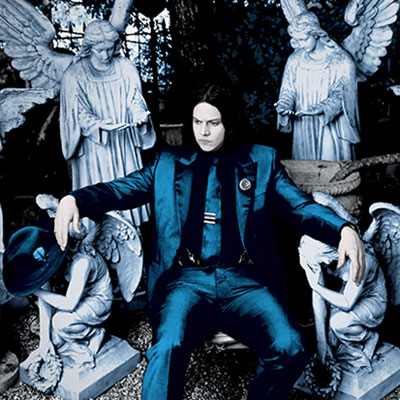On the title track of Lazaretto, his second solo album, Jack White sings of escaping a quarantine station on the Isle of Man. Like many of White’s lyrics, his situation could be fictional or the summoning of a past life experience. Over a recurring 12 note progression which doubles as a riff, he outlines his imprisonment in his distinctive tremor: "I have no time left/ Time is lost/ No time at all/ Throw it in a garbage can". He seems resigned to defeat until he suddenly finds inspiration in escape. As Lazaretto launches into the first of its two solos, White shouts "This is how I’m gonna do it". The result is both cathartic and preposterous.
Ever since he formed The White Stripes in Detroit in 1997, White has been compared to a number of fictional and non-fictional figures, most memorably Roald Dahl’s Willy Wonka – an eccentric DIY enthusiast turned entrepreneur. His lo-fi religiosity has been well chronicled over the course of six White Stripes studio recordings and multiple side projects . He builds his own furniture, makes his own guitars, owns a recording studio and label, and designs interiors and clothing. In pronunciations of his fondness for couches, radio controlled boats and 180 gram vinyl, he sounds incapable of self-censorship. At the peak of their fame in 2007, the White Stripes played concerts at a bowling alley and a home for retirees. Another concert was comprised of just the musical note "E". White has also toured with all-male and all-female bands on rotation, deciding to perform with the Buzzards or the Peacocks at breakfast.
Unlike Blunderbuss and previous White Stripes albums, which were recorded in several weeks each, Lazaretto is built on indulgence. In comparison to the Spartan arrangements on White Blood Cells, Lazaretto sees White move from an inner city warehouse into a Gulf palace. The songwriter, who is now 38 years old, went through his teenage diaries, adapting entries into lyrics. The album took 18 months to complete. In contrast to his usual bang-it-to-a-wall approach, White’s latest endeavour is like having Fugazi’s Ian MacKaye oversee a Def Leppard album.
Unsurprisingly, much of Lazaretto initially sounds ludicrous. While Blunderbuss was lean and focused, in its evocation of Southern gothic, Lazaretto is overloaded with tack piano playing, swamp blues and fuzzy basslines. The album’s liner notes credit over 30 musicians. Lazaretto‘s opening song, a tubercular re-reading of Blind Willie McTell’s ‘Three Women Blues’ has White outline a triptych of relationships: "I got three women, red blonde and brunette. It took a digital photograph to pick which one I like". An exclamatory slide guitar punctuates proceedings two verses later: "Yeah, I know what you’re thinking/ What gives me the right?/ Well, these women must be getting something/ Because they come and see me every night." In all, ‘Three Women’ alternates between four time shifts, slide guitar, and a gospel chorus before finally collapsing in exhaustion.
As a guitar player, White has few contemporary equals. Modern guitarists such as John Frusciante, John Mayer and Derek Trucks might subscribe to the same interpretation of traditional Chicago or delta blues; only White takes pleasure in all the sonic extremities the instrument offers. While Frusciante, Mayer and Trucks are Protestant with their overindulgence, White embraces gluttony. Parts of Lazaretto would sound at home on some of the most bombastic records of the last forty years, Led Zeppelin’s Physical Graffiti, Queen’s A Day At The Races and even Elton John’s Goodbye Yellow Brick Road.
Looking for a betrayal of White’s inner thoughts and preoccupations in any of his work can prove frustrating – like Bob Dylan, he revels in creating myths and half-truths. Yet even the blockbuster production of Lazaretto can’t mask the pain of The White Stripes breakup and two public divorces. On ‘Would You Fight For My Love?’, he sings "And so then there I am, the caretaker of sin/ To your abandoned and malignant heart". Later, on ‘All Alone In My Home’ he sings of a recovery: "These stones/ That are thrown against my bone/ Break through/ But they hurt less as time goes on".
Lazaretto occasionally suffers from the burden of White’s own ambition. The instrumental ‘High Ball Stepper’ – a centerpiece for his guitar-playing – explodes with heavy notes of distortion and thunderous drumming. You can imagine the song, like much of the music White has released over a two decade career, was a delight to demo and record. By the time it ends, however, the track begs for a chorus, a finale or a musical foil. Instead, it drifts away into black space until White strikes his guitar with impetuous fury. You can sense his frustration; some of White’s most accomplished music has been achieved by collaborating with other songwriters, notably in The Raconteurs and the Dead Weather.
Elsewhere, the album demonstrates astonishing moments of focus. There is much to admire about a collection of songs which look to 1968 and 2014 for inspiration. White’s abilities as a producer have been honed by his many extra-curricular activities: the drums, pianos and guitars hum and crackle with excitement. And while Lazaretto occasionally hints at some of the excesses of the producer/songwriter genre, what’s undeniable is the talent on display. White has compressed as many ideas into 11 songs as most songwriters manage over a career.


